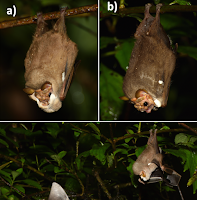 |
| Centurio senex Gray, 1842 in Rodríguez-Herrera, Sánchez-Calderón, Madrigal-Elizondo, et al., 2020. |
Abstract
Centurio senex is an iconic bat characterized by a facial morphology deviating far from all other New World Leaf Nosed Bats (Phyllostomidae). The species has a bizarrely wrinkled face and lacks the characteristic nose leaf. Throughout its distribution from Mexico to Northern South America the species is most of the time rarely captured and only scarce information on its behavior and natural history is available. Centurio senex is frugivorous and one of the few bats documented to consume also hard seeds. Interestingly, the species shows a distinct sexual dimorphism: Adult males have more pronounced facial wrinkles than females and a fold of skin under the chin that can be raised in style of a face mask. We report the first observations on echolocation and mating behavior of Centurio senex, including synchronized audio and video recordings from an aggregation of males in Costa Rica. Over a period of 6 weeks we located a total of 53 perches, where during the first half of the night males were hanging with raised facial masks at a mean height of 2.35 m. Most of the time, the males moved just their wing tips, and spontaneously vocalized in the ultrasound range. Approaches of other individuals resulted in the perching male beating its wings and emitting a very loud, low frequency whistling call. Following such an encounter we recorded a copulation event. The observed aggregation of adult C. senex males is consistent with lek courtship, a behavior described from only few other bat species.
Conclusion:
Our study summarizes the first behavioral data from a lek of Centurio senex males, observed over a period of almost 6 weeks at a Costa Rican highland forest site. The exclusively male bats used stable perches and showed distinct behavioral patterns including an acoustic signaling with stereotypical elements that might serve to attract females and perhaps also to signal male quality. Perching animals were regularly approached by other individuals and in one case such an encounter was followed by a copulation. Males often spent several hours on the perch without leaving and abandoned it only after midnight. This endurance left males with only half of the night time for foraging, so the time spent on the perch is a significant energetic investment and could be a honest signal for male quality. Our study has some obvious shortcomings. While we were extremely lucky to obtain the first observations on the behavior of this interesting species we deliberately refrained from mist-netting bats in order not to scare the animals away from our study site. The downside of this cautious approach is, however, that we still lack essential data, such as the sex ratio at the site, the body condition of individual males or the identity of all visitors. In this context, it would also be highly interesting to assess potential olfactory signals of the perching males, perhaps in the facial region. Hopefully, the encounter of a future lek of Centurio senex will allow us to close some of the current gaps in the knowledge on the behavior of one of the most iconic bats of the Neotropics.
Bernal Rodríguez-Herrera, Ricardo Sánchez-Calderón, Victor Madrigal-Elizondo, Paulina Rodríguez, Jairo Villalobos, Esteban Hernández, Daniel Zamora-Mejías, Gloria Gessinger and Marco Tschapka. 2020. The Masked Seducers: Lek Courtship Behavior in the Wrinkle-faced Bat Centurio senex (Phyllostomidae). PLoS ONE. 15(11): e0241063. DOI: 10.1371/journal.pone.0241063
Wrinkle-faced male bats lower face masks to copulate
The first behavioral observations of wrinkle-faced bats in their natural habitat reveal that this elusive species uses the rarest form of bat courtship behavior, according to a new study.





